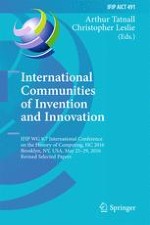
2016 | OriginalPaper | Chapter
The Route Less Taken: The Homegrown Los Alamos Integrated Computer Network
Author : Nicholas Lewis
Published in: International Communities of Invention and Innovation
Publisher: Springer International Publishing
Activate our intelligent search to find suitable subject content or patents.
Select sections of text to find matching patents with Artificial Intelligence. powered by
Select sections of text to find additional relevant content using AI-assisted search. powered by